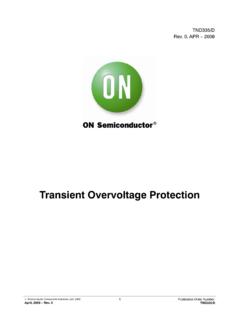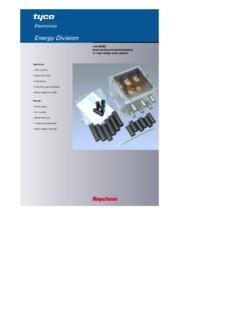Transcription of 5.4.2 Standard EN 50160 Voltage Characteristics in …
1 Power Quality Application GuideVoltage DisturbancesStandard EN 50160 Voltage Characteristics inPublic distribution SystemsVoltage Development AssociationIEE Endorsed Providershort supply interruption t<3 minsvoltage dip, t> 10 msFluke (UK) LtdVoltage DisturbancesStandard EN 50160 - Voltage Characteristics in public distribution SystemsHenryk Markiewicz & Antoni KlajnWroclaw University of TechnologyJuly 2004 This Guide has been produced as part of the Leonardo Power Quality Initiative (LPQI), aEuropean education and training programme supported by the European Commission(under the Leonardo da Vinci Programme) and International Copper Association. For further informationon LPQI visit Development Association (CDA)Copper Development Association is a non-trading organisation sponsored by the copperproducers and fabricators to encourage the use of copper and copper alloys and to promote theircorrect and efficient application.
2 Its services, which include the provision of technical advice andinformation, are available to those interested in the utilisation of copper in all its aspects. The Associationalso provides a link between research and the user industries and maintains close contact with the othercopper development organisations throughout the is an IEE endorsed provider of seminar training and learning Copper Institute (ECI)The European Copper Institute is a joint venture between ICA (InternationalCopper Association) and the European fabricating industry. Through itsmembership, ECI acts on behalf of the world s largest copper producers andEurope s leading fabricators to promote copper in Europe. Formed in January 1996, ECI is supported by anetwork of eleven Copper Development Associations ( CDAs ) in Benelux, France, Germany, Greece,Hungary, Italy, Poland, Russia, Scandinavia, Spain and the content of this project does not necessarily reflect the position of the European Community, nor doesit involve any responsibility on the part of the European Copper Institute, Wroclaw University of Technology and Copper Development Associationdisclaim liability for any direct, indirect, consequential or incidental damages that may result from the useof the information, or from the inability to use the information or data contained within this European Copper Institute, Wroclaw University of Technology and Copper is authorised providing the material is unabridged and the source is is promoted in the UK by members of the Power Quality Partnership.
3 Rhopoint Systems LtdMGE UPS Systems Ltd LEM InstrumentsStandard EN 50160 - Voltage Characteristics of public distribution SystemsIntroductionElectrical energy is a product and, like any other product, should satisfy the proper quality requirements. Ifelectrical equipment is to operate correctly, it requires electrical energy to be supplied at a Voltage that iswithin a specified range around the rated value. A significant part of the equipment in use today, especiallyelectronic and computer devices, requires good power quality (PQ). However, the same equipment oftencauses distortion of the Voltage supply in the installation, because of its non-linear Characteristics , itdraws a non-sinusoidal current with a sinusoidal supply Voltage (see Section of this Guide). Thus,maintaining satisfactory PQ is a joint responsibility for the supplier and the electricity user.
4 According tostandard EN 50160 [1] the supplier is the party who provides electricity via a public distribution system, andthe user or customer is the purchaser of electricity from a supplier. The user is entitled to receive a suitablequality of power from the supplier. In practice the level of PQ is a compromise between user and the available PQ is not sufficient for the user s needs, PQ improvement measures will be needed andwill be the subject of a cost-benefit analysis (see Section of this Guide). However, the cost of poor PQusually exceeds the cost of measures required for improvement - it is estimated that losses caused by poorpower quality cost EU industry and commerce about 10 billion per annum (see Section of this Guide).However, electrical energy is a very specific product. The possibility for storing electricity in any significantquantity is very limited so it is consumed at the instant it is generated.
5 Measurement and evaluation of thequality of the supplied power has to be made at the instant of its consumption. The measurement of PQ iscomplex, since the supplier and user, whose sensitive electrical equipment is also a source of disturbances,have different perspectives. Standard IEC 038 [2] distinguishes two different voltages in electrical networks and installations: supply Voltage , which is the line-to-line or line-to-neutral Voltage at the point of common coupling, main supplying point of installation utility Voltage , which is the line-to-line or line-to-neutral Voltage at the plug or terminal of theelectrical main document dealing with requirements concerning the supplier s sideis Standard EN 50160 , whichcharacterises Voltage parameters of electrical energy in public distribution systems. This is a Europeanstandard but it is supplemented in some regions or countries by other supplemental standards , such as [3]in Germany, or [4] in Poland.
6 Many regional codes, such as the German TAB [3] apply to an individualutility, but these are being unified as part of the liberalisation of the German electricity market. Accordingto IEC 038, both Standard EN 50160 and rules [3,4] concern the supply Voltage , that measured at thepoint of common the user s side, it is the quality of power available to the user s equipment that is important. Correctequipment operation requires the level of electromagnetic influence on equipment to be maintained belowcertain limits. Equipment is influenced by disturbances on the supply and by other equipment in theinstallation, as well as itself influencing the supply. These problems are summarised in the EN 61000 seriesof EMC standards , in which limits of conducted disturbances are characterised.
7 Equipment sensitivity toutility Voltage quality, as well as mitigation measures, are presented in Section 3 (Harmonics) and Section 5( Voltage Disturbances) of this subject of this section is a detailed presentation of Standard EN 50160 and an analysis of itsrequirements according to the operation of chosen equipment. Methods of measuring supply voltageparameters are also Disturbances1 Basic definitions of Voltage parameters In Standard EN 50160 several Voltage parameters are defined. The most important are:Supply Voltage the rms value of the Voltage at a given moment at the point of common coupling, measuredover a given time Voltage of the system (Un) the Voltage by which a system is designated or identified and to whichcertain operating Characteristics are supply Voltage (Uc) is normally the nominal Voltage Unof the system.
8 If, by agreement betweenthe supplier and the user, a Voltage different from the nominal Voltage is applied to the terminal, then thisvoltage is the declared supply Voltage operating condition the condition of meeting load demand, system switching and clearing faultsby automatic system protection in the absence of exceptional conditions due to external influences ormajor variation is an increase or decrease of Voltage , due to variation of the total load of the distributionsystem or a part of impression of unsteadiness of visual sensation induced by a light stimulus, the luminance orspectral distribution of which fluctuates with severity intensity of flicker annoyance defined by the UIE-IEC flicker measuring method andevaluated by the following quantities: Short term severity (Pst) measured over a period of ten minutes Long term severity (Plt) calculated from a sequence of 12 Pst values over a two-hour interval,according to the following expression:Supply Voltage dip a sudden reduction of the supply Voltage to a value between 90% and 1% of thedeclared Voltage Uc, followed by a Voltage recovery after a short period of time.
9 Conventionally the durationof a Voltage dip is between 10 ms and 1 minute. The depth of a Voltage dip is defined as the differencebetween the minimum rms Voltage during the Voltage dip and the declared Voltage . Voltage changes whichdo not reduce the supply Voltage to less than 90% of the declared Voltage Ucare not considered to be interruption is a condition in which the Voltage at the supply terminals is lower than 1% of thedeclared Voltage Uc. A supply interruption is classified as: prearrangedin order to allow the execution of scheduled works on the distribution system, whenconsumers are informed in advance accidental,caused by permanent (a long interruption) or transient (a short interruption) faults,mostly related to external events, equipment failures or power frequency overvoltages have relatively long duration, usually of a few power frequencyperiods, and originate mainly from switching operations or faults, sudden load reduction, ordisconnection of short overvoltages are oscillatory or non-oscillatory, highly damped, short overvoltages with aduration of a few milliseconds or less, originating from lightning or some switching operations, for exampleat switch-off of an inductive Voltage a sinusoidal Voltage with a frequency equal to an integer multiple of the fundamentalfrequency of the supply Voltage .
10 Harmonic voltages can be evaluated: individuallyby their relative amplitude Uhrelated to the fundamental Voltage U1, where his theorder of the harmonic2 Voltage Characteristics of public distribution Systems3121312 ==istiltPP(1) globally, usually by the total harmonic distortion factor THDU, calculated using the followingexpression:Interharmonic Voltage is a sinusoidal Voltage with frequency between the harmonics, the frequency isnot an integer multiple of the unbalance is a condition where the rms value of the phase voltages or the phase angles betweenconsecutive phases in a three-phase system are not requirements of EN 50160 EN 50160 gives the main Voltage parameters and their permissible deviation ranges at the customer s pointof common coupling in public low Voltage (LV ) and medium Voltage (MV ) electricity distribution systems,under normal operating conditions.





